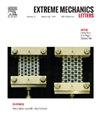基于等参数元素的复杂设计域结构拓扑优化--与问题无关的机器学习增强型结构拓扑优化
IF 4.3
3区 工程技术
Q2 MATERIALS SCIENCE, MULTIDISCIPLINARY
引用次数: 0
摘要
拓扑优化需要数十次甚至数百次迭代,每次迭代都需要进行完整的有限元分析(FEA)。巨大的计算成本限制了拓扑优化在工程中的应用,尤其是对于包含复杂设计域的高分辨率问题。为了解决这个问题,我们提出了一种基于等参数元素的与问题无关的机器学习(PIML)模型。该模型可有效减少有限元分析的计算时间,实现高效拓扑优化,并将可解决的问题范围扩展到复杂设计领域。其基本思想是利用子结构方法,并通过机器学习模型建立子结构内元素形状和材料分布与其数值形状函数的映射关系。样本生成和模型训练都是离线进行的,这样就可以在拓扑优化过程中直接使用训练好的机器学习模型。由于子结构的形状函数与问题无关,因此在改变优化问题的几何形状或边界条件时,无需重新生成样本或修改所提出的机器学习模型。数值实例表明,在没有并行技术的情况下,所提出的机器学习模型能将拓扑优化的效率提高一个数量级。本文章由计算机程序翻译,如有差异,请以英文原文为准。
Problem-independent machine learning-enhanced structural topology optimization of complex design domains based on isoparametric elements
Topology optimization requires dozens or even hundreds of iterations, each requiring a complete finite element analysis (FEA). Significant computation cost limits the application of topology optimization in engineering, especially for high-resolution problems containing complex design domains. To address the issue, a Problem-Independent Machine Learning (PIML) model based on isoparametric elements is proposed. Effectively reducing the computational time of FEA, the proposed model enables efficient topology optimization and extends the solvable problem range to complex design domains. The essential idea is leveraging the substructure method and establishing a mapping from element shapes and material distribution within the substructure to its numerical shape functions through machine learning models. Both sample generation and model training are conducted offline, allowing the trained machine learning model to be directly employed during the topology optimization process. Since the shape function of the substructure is problem-independent, it requires no sample regeneration or modification of the proposed machine learning model when changing the geometry or boundary conditions of the optimization problem. Numerical examples demonstrate that the proposed machine learning model boosts the efficiency of topology optimization by one order of magnitude without parallel techniques.
求助全文
通过发布文献求助,成功后即可免费获取论文全文。
去求助
来源期刊

Extreme Mechanics Letters
Engineering-Mechanics of Materials
CiteScore
9.20
自引率
4.30%
发文量
179
审稿时长
45 days
期刊介绍:
Extreme Mechanics Letters (EML) enables rapid communication of research that highlights the role of mechanics in multi-disciplinary areas across materials science, physics, chemistry, biology, medicine and engineering. Emphasis is on the impact, depth and originality of new concepts, methods and observations at the forefront of applied sciences.
 求助内容:
求助内容: 应助结果提醒方式:
应助结果提醒方式:


